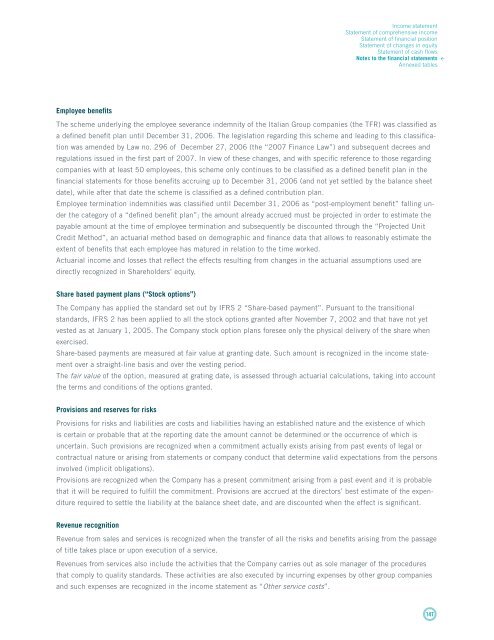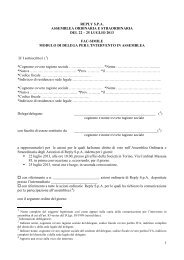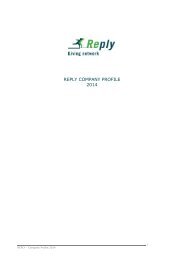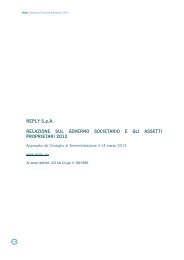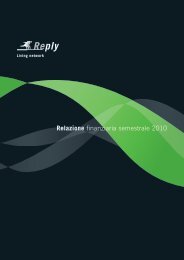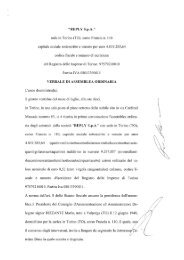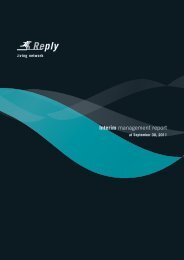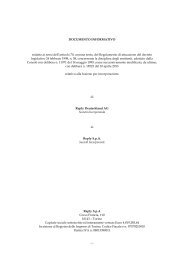Reply SpA
Reply SpA
Reply SpA
You also want an ePaper? Increase the reach of your titles
YUMPU automatically turns print PDFs into web optimized ePapers that Google loves.
Income statement<br />
Statement of comprehensive income<br />
Statement of financial position<br />
Statement of changes in equity<br />
Statement of cash flows<br />
Notes to the financial statements<br />
Annexed tables<br />
<br />
Employee benefits<br />
The scheme underlying the employee severance indemnity of the Italian Group companies (the TFR) was classified as<br />
a defined benefit plan until December 31, 2006. The legislation regarding this scheme and leading to this classification<br />
was amended by Law no. 296 of December 27, 2006 (the “2007 Finance Law”) and subsequent decrees and<br />
regulations issued in the first part of 2007. In view of these changes, and with specific reference to those regarding<br />
companies with at least 50 employees, this scheme only continues to be classified as a defined benefit plan in the<br />
financial statements for those benefits accruing up to December 31, 2006 (and not yet settled by the balance sheet<br />
date), while after that date the scheme is classified as a defined contribution plan.<br />
Employee termination indemnities was classified until December 31, 2006 as “post-employment benefit” falling under<br />
the category of a “defined benefit plan”; the amount already accrued must be projected in order to estimate the<br />
payable amount at the time of employee termination and subsequently be discounted through the “Projected Unit<br />
Credit Method”, an actuarial method based on demographic and finance data that allows to reasonably estimate the<br />
extent of benefits that each employee has matured in relation to the time worked.<br />
Actuarial income and losses that reflect the effects resulting from changes in the actuarial assumptions used are<br />
directly recognized in Shareholders’ equity.<br />
Share based payment plans (“Stock options”)<br />
The Company has applied the standard set out by IFRS 2 “Share-based payment”. Pursuant to the transitional<br />
standards, IFRS 2 has been applied to all the stock options granted after November 7, 2002 and that have not yet<br />
vested as at January 1, 2005. The Company stock option plans foresee only the physical delivery of the share when<br />
exercised.<br />
Share-based payments are measured at fair value at granting date. Such amount is recognized in the income statement<br />
over a straight-line basis and over the vesting period.<br />
The fair value of the option, measured at grating date, is assessed through actuarial calculations, taking into account<br />
the terms and conditions of the options granted.<br />
Provisions and reserves for risks<br />
Provisions for risks and liabilities are costs and liabilities having an established nature and the existence of which<br />
is certain or probable that at the reporting date the amount cannot be determined or the occurrence of which is<br />
uncertain. Such provisions are recognized when a commitment actually exists arising from past events of legal or<br />
contractual nature or arising from statements or company conduct that determine valid expectations from the persons<br />
involved (implicit obligations).<br />
Provisions are recognized when the Company has a present commitment arising from a past event and it is probable<br />
that it will be required to fulfill the commitment. Provisions are accrued at the directors’ best estimate of the expenditure<br />
required to settle the liability at the balance sheet date, and are discounted when the effect is significant.<br />
Revenue recognition<br />
Revenue from sales and services is recognized when the transfer of all the risks and benefits arising from the passage<br />
of title takes place or upon execution of a service.<br />
Revenues from services also include the activities that the Company carries out as sole manager of the procedures<br />
that comply to quality standards. These activities are also executed by incurring expenses by other group companies<br />
and such expenses are recognized in the income statement as “Other service costs”.<br />
147


